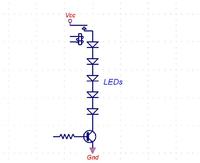daviddlc
Full Member level 5
I'm working in a display project, which has a microcontroller controlling 7 segment displays made out of LEDs.
It has 10 ~ 7 segment displays multiplexed and the brightness on the segments is too low.
I already have changed the multiplexing frequency, and the resistor value on the swithching transistor, but stillwould like to have more brigthness, and I have no option to change to high intensity LEDs due cost $$$$ reasons.
Any suggestion ?

Added after 3 minutes:
I'm using a solid state relay for multiplexing and the transistor to turn on and off the segments.
It has 10 ~ 7 segment displays multiplexed and the brightness on the segments is too low.
I already have changed the multiplexing frequency, and the resistor value on the swithching transistor, but stillwould like to have more brigthness, and I have no option to change to high intensity LEDs due cost $$$$ reasons.
Any suggestion ?

Added after 3 minutes:
I'm using a solid state relay for multiplexing and the transistor to turn on and off the segments.
